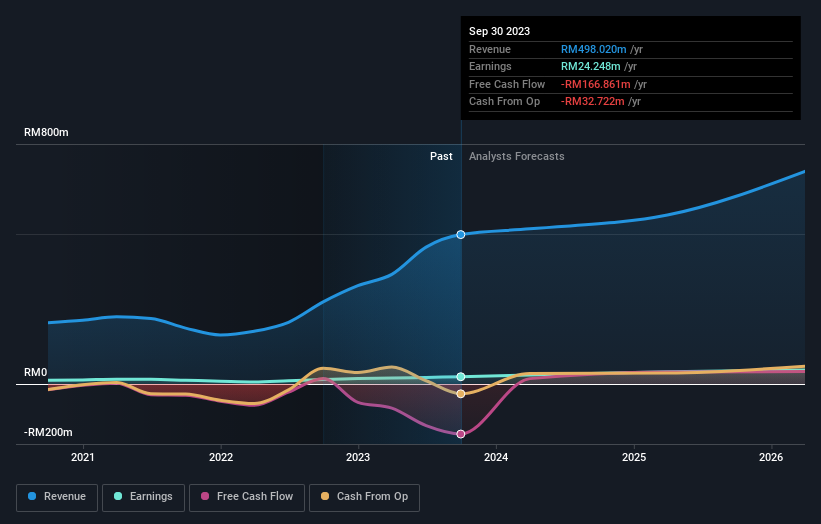While individual investors own 32% of Solarvest Holdings Berhad (KLSE:SLVEST), private companies are its largest shareholders with 33% ownership
Key Insights
Significant control over Solarvest Holdings Berhad by private companies implies that the general public has more power to influence management and governance-related decisions
A total of 5 investors have a majority stake in the company with 52% ownership
If you want to know who really controls Solarvest Holdings Berhad (KLSE:SLVEST), then you'll have to look at the makeup of its share registry. The group holding the most number of shares in the company, around 33% to be precise, is private companies. In other words, the group stands to gain the most (or lose the most) from their investment into the company.
And individual investors on the other hand have a 32% ownership in the company.
In the chart below, we zoom in on the different ownership groups of Solarvest Holdings Berhad.
See our latest analysis for Solarvest Holdings Berhad
What Does The Institutional Ownership Tell Us About Solarvest Holdings Berhad?
Institutions typically measure themselves against a benchmark when reporting to their own investors, so they often become more enthusiastic about a stock once it's included in a major index. We would expect most companies to have some institutions on the register, especially if they are growing.
Solarvest Holdings Berhad already has institutions on the share registry. Indeed, they own a respectable stake in the company. This can indicate that the company has a certain degree of credibility in the investment community. However, it is best to be wary of relying on the supposed validation that comes with institutional investors. They too, get it wrong sometimes. When multiple institutions own a stock, there's always a risk that they are in a 'crowded trade'. When such a trade goes wrong, multiple parties may compete to sell stock fast. This risk is higher in a company without a history of growth. You can see Solarvest Holdings Berhad's historic earnings and revenue below, but keep in mind there's always more to the story.
Hedge funds don't have many shares in Solarvest Holdings Berhad. Looking at our data, we can see that the largest shareholder is Atlantic Blue Holdings Sdn Bhd with 23% of shares outstanding. Chin Siu Lim is the second largest shareholder owning 10% of common stock, and Divine Inventions Sdn. Bhd. holds about 9.0% of the company stock. Chin Siu Lim, who is the second-largest shareholder, also happens to hold the title of Senior Key Executive. Furthermore, CEO Chun Chong is the owner of 3.2% of the company's shares.
To make our study more interesting, we found that the top 5 shareholders control more than half of the company which implies that this group has considerable sway over the company's decision-making.
While it makes sense to study institutional ownership data for a company, it also makes sense to study analyst sentiments to know which way the wind is blowing. Quite a few analysts cover the stock, so you could look into forecast growth quite easily.
Insider Ownership Of Solarvest Holdings Berhad
While the precise definition of an insider can be subjective, almost everyone considers board members to be insiders. The company management answer to the board and the latter should represent the interests of shareholders. Notably, sometimes top-level managers are on the board themselves.
Insider ownership is positive when it signals leadership are thinking like the true owners of the company. However, high insider ownership can also give immense power to a small group within the company. This can be negative in some circumstances.
Our information suggests that insiders maintain a significant holding in Solarvest Holdings Berhad. It has a market capitalization of just RM836m, and insiders have RM212m worth of shares in their own names. It is great to see insiders so invested in the business. It might be worth checking if those insiders have been buying recently.
General Public Ownership
The general public, who are usually individual investors, hold a 32% stake in Solarvest Holdings Berhad. While this group can't necessarily call the shots, it can certainly have a real influence on how the company is run.
Private Company Ownership
Our data indicates that Private Companies hold 33%, of the company's shares. It's hard to draw any conclusions from this fact alone, so its worth looking into who owns those private companies. Sometimes insiders or other related parties have an interest in shares in a public company through a separate private company.
Next Steps:
It's always worth thinking about the different groups who own shares in a company. But to understand Solarvest Holdings Berhad better, we need to consider many other factors. To that end, you should be aware of the 2 warning signs we've spotted with Solarvest Holdings Berhad .
If you would prefer discover what analysts are predicting in terms of future growth, do not miss this free report on analyst forecasts.
NB: Figures in this article are calculated using data from the last twelve months, which refer to the 12-month period ending on the last date of the month the financial statement is dated. This may not be consistent with full year annual report figures.
Have feedback on this article? Concerned about the content? Get in touch with us directly. Alternatively, email editorial-team (at) simplywallst.com.
This article by Simply Wall St is general in nature. We provide commentary based on historical data and analyst forecasts only using an unbiased methodology and our articles are not intended to be financial advice. It does not constitute a recommendation to buy or sell any stock, and does not take account of your objectives, or your financial situation. We aim to bring you long-term focused analysis driven by fundamental data. Note that our analysis may not factor in the latest price-sensitive company announcements or qualitative material. Simply Wall St has no position in any stocks mentioned.

 Yahoo Finance
Yahoo Finance 

